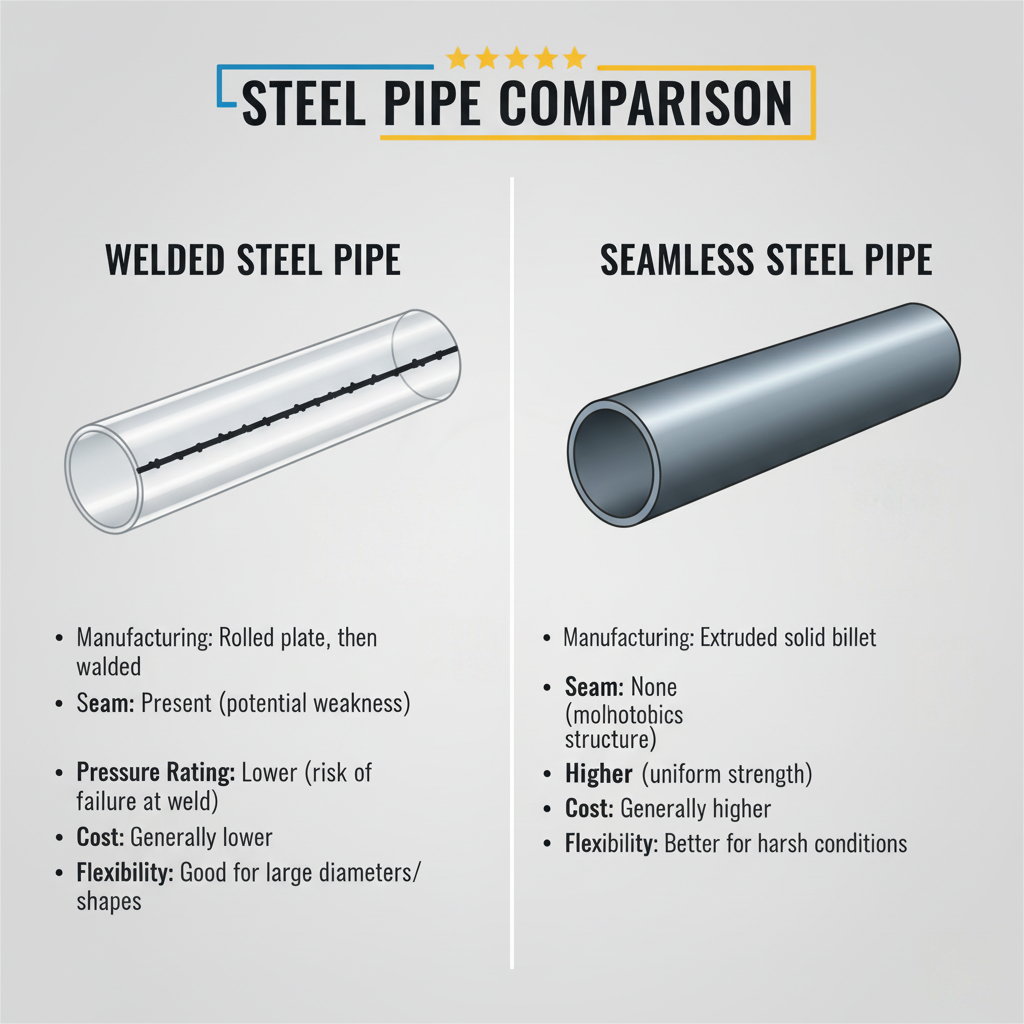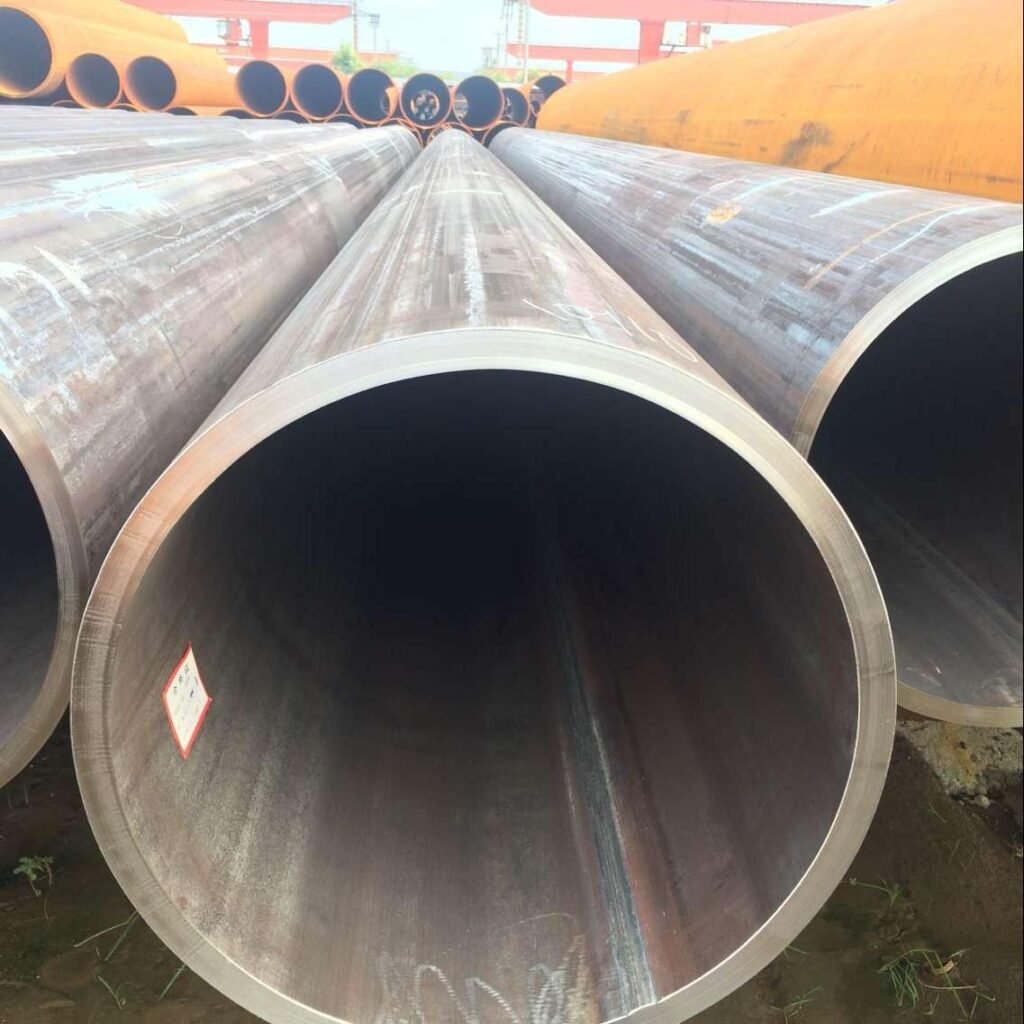Large-diameter steel pipes are fundamental to global infrastructure, particularly for transporting vast quantities of oil and gas. Typically, we’re talking about pipes exceeding 16 inches in diameter, extending up to an impressive 100 inches. Their role in long-distance pipeline projects is critical, as they enable significantly higher volumes of liquid and increased flow rates.
Over recent years, the demand and application for these Large Diameter Steel pipes have seen a consistent rise, underscoring their growing importance across various industrial sectors.
How Are These pipes made? Welded vs. Seamless
Primarily, these Large-diameter steel pipes are produced through welding, specifically as LSAW (Longitudinal Submerged Arc Welded) or SSAW (Spiral Submerged Arc Welded) pipes.
However, a significant alternative exists: seamless large diameter steel pipes, manufactured through hot expanding processes.
The distinction between SAW steel pipe and seamless pipes is crucial, especially when considering applications involving high pressure. For such demanding environments, large diameter seamless pipes are generally preferred.
The primary reason is the inherent vulnerability of welded pipes: the weld seam.
This seam represents the weakest point in a welded pipe, making it more susceptible to failure or cracking under intense pressure compared to its seamless counterpart. Consequently, industries are increasingly seeking seamless large pipes for critical applications where integrity under pressure is paramount.

Material Matters: Standards and Alloys
A wide array of steel materials can be utilized in the production of large diameter steel pipes. Here’s a look at common standards for carbon steel and chrome-moly alloy pipes:
- API 5L: Ranging from Grade B, X42, X46, X52 all the way up to X80. These are crucial for pipeline transportation systems.
- ASTM A53B: A standard specification for pipe, steel, black and hot-dipped, zinc-coated, welded and seamless.
- ASTM A252 Grade 2, 3: Primarily used for welded and seamless steel pipe piles.
- ASTM A671: Specification for electric-fusion-welded steel pipe for atmospheric and lower temperatures.
- ASTM A672: Specification for electric-fusion-welded steel pipe for high-pressure service at moderate temperatures.
- ASTM A691: Specification for carbon and alloy steel pipe, electric-fusion-welded for high-pressure service at high temperatures.
- ASTM A106B: Standard specification for seamless carbon steel pipe for high-temperature service.
The Role of Large Diameter Steel Pipe
Beyond carbon and alloy steels, large diameter stainless steel pipes are indispensable in many industries. They are used for fluid transmission, as well as for manufacturing machine parts. These are predominantly produced using TIG welding. Common material standards include ASTM A312 or EN 10088-3, with popular grades like:
- TP304/L/H, S30400, S30403, S31409
- TP316/L/H, S31600, S31603, S31609
- TP310S/H, S31008, S31009
- TP321/H, S32100, S32109
- TP347/H, S34700, S34709
- 904/L
These stainless steel options offer superior corrosion resistance, making them ideal for specific, often harsh, operational environments.

Defining “Large Diameter” in Pipe Terminology
When do we actually start calling a pipe “large diameter”? Generally, this term applies to pipes with an outside diameter exceeding 457 mm (16 inches) or 508 mm (20 inches).
- For ERW (Electric Resistance Welded) steel pipes, the maximum typical diameter is around 457 mm (16 inches). Therefore, pipes with diameters larger than this are consistently classified as large diameter.
- For LSAW and SSAW steel pipes: The range for large diameter extends from 508 mm (20 inches) up to 2540 mm (100 inches).
- For large diameter seamless pipe: This also refers to pipes greater than 16 inches or 20 inches. Pipes exceeding these sizes typically aren’t manufactured solely by hot rolling. Instead, an additional process called “hot expanding” is employed. This method allows for enlarging pipe diameters efficiently, at a lower cost, and with high productivity, establishing it as a modern and effective way to produce large seamless pipes.
The Hot Expanding Process Explained
Hot expanding, also known as thermal expansion, is a crucial technique for producing large diameter seamless pipes. The process involves heating the pipe to a temperature near its transformation point. Then, specialized methods like corner skew rolling or hot drawing are used to expand the seamless pipe’s diameter to the desired size. This technique is vital for achieving the larger dimensions that conventional hot rolling alone cannot deliver for seamless pipes.
Essential Considerations Before Purchasing Large Diameter Seamless Pipe
Navigating the market for large diter seamless pipes can be challenging without proper knowledge. To ensure you acquire high-quality products that meet your specific needs, consider these critical points before making a purchase:
- The Absolute Absence of Seams
This is the defining characteristic: a seamless pipe must have absolutely no weld seam on its body.
Be wary of claims where a “seam” might have been removed in an undetectable way – this defeats the purpose of seamless construction. A true large-diameter seamless pipe is manufactured through a specific, rigorous process.
It starts with a solid, round billet (a cylindrical metal block). This billet is then heated to a very high temperature. Precision is key here; the temperature must be high enough for malleability but carefully controlled to prevent melting. After heating, the billet is stretched and pulled over a mandrel until it takes the shape of a hollow tube.
It’s common for contractors, perhaps due to familiarity or cost, to suggest welded pipes. However, for critical applications, you must be vigilant and insist on genuinely seamless large pipes. The integrity of a seamless pipe comes from its continuous structure, free from the stresses and potential weaknesses associated with a welded joint.
- Imperative for Uniform Roundness
The next critical factor is the uniformity and precision of the pipe’s roundness. Welded seam pipes, by their nature, are typically formed by wrapping metal plates around a form before welding. The welding process itself, involving stress, heat, and other variables, can make it incredibly difficult to achieve a perfectly round finished product. This can lead to ovality or other deviations from a true circle.
In contrast, seamless steel pipe is produced through a continuous extrusion of alloy. This manufacturing method inherently results in a consistently round cross-section. This precise roundness is often essential, particularly when these pipes are used in construction processes, for accurate fitting, or when installing them within complex systems where dimensional accuracy is paramount. A truly round pipe ensures better fit-up, reduced installation time, and enhanced performance.
- Superior Pressure Bearing Capability
One of the most compelling advantages of large seamless pipe is its superior ability to withstand high pressure compared to large welded pipe. While seamless pipes may carry a higher initial cost, this investment often translates into greater reliability, especially under demanding conditions. Welded pipes inherently risk failure at the weld seam when subjected to significant internal pressure. This risk is virtually eliminated with seamless pipes due to their monolithic structure.
Pipes must support not only their own weight but also the weight of the material they transport, as well as external loads. In scenarios where pipes are under continuous high pressure or significant external stress, seamless pipes provide unmatched confidence. Leaks and pipe failures are predominantly observed in welded pipes, specifically at the seam. The absence of a weld seam in seamless pipes eliminates this primary point of potential failure, offering a significantly more robust solution.
- Performance in Extreme Operating Conditions
Another significant attribute of large seamless pipes is their remarkable capability to operate effectively under extremely harsh environmental conditions, be it intensely cold or exceedingly hot. The continuous, homogenous structure of seamless pipes allows them to maintain their integrity and performance across a broader temperature spectrum.
Welded pipes, on the other hand, can be more susceptible to issues in extreme conditions. The weld material and the heat-affected zone around the weld can react differently to thermal expansion and contraction compared to the base material, potentially leading to stress concentrations, cracking, or material degradation. This makes seamless pipes the preferred choice for critical applications in environments with significant temperature fluctuations or extreme highs and lows, where reliability cannot be compromised.
Cost Differences Across Large Diameter Pipe Types
The cost structure for large diameter pipes varies depending on the manufacturing method:
Large seamless pipes after hot expanding: These typically have a lower price than standard hot-rolled seamless pipes. This is partly due to the process itself and potentially a slight reduction in steel density from the expansion. However, they are still generally more expensive than large welded pipes, such as SSAW and LSAW types.
While the upfront price of large diameter seamless pipe might be higher than their welded counterparts, their enhanced capabilities and long-term benefits often make them the more appropriate and cost-effective choice in the long run. The increasing demand for seamless large pipes in various commercial applications underscores their growing importance. These applications include critical infrastructure like oil rigs and gas pipelines, shipbuilding, offshore rigs, machinery parts, pressure vessels, and a wide array of oilfield equipment. The reliability, strength, and durability of seamless pipes often outweigh the initial cost difference, leading to significant savings in maintenance, repairs, and potential downtime over the lifecycle of a project.
By thoroughly understanding these aspects of large diameter steel pipes, you can make a truly informed decision, ensuring safety, efficiency, and longevity for your projects.
JSFITTINGS-China leading large diameter steel pipes supplier&exporter, makes your purchase of Chinese steel pipes fast and efficient. Free Samples Available.
Contact for a free quote.
Email: info@jssteelpipes.com
WhatsApp: +8618003119682


